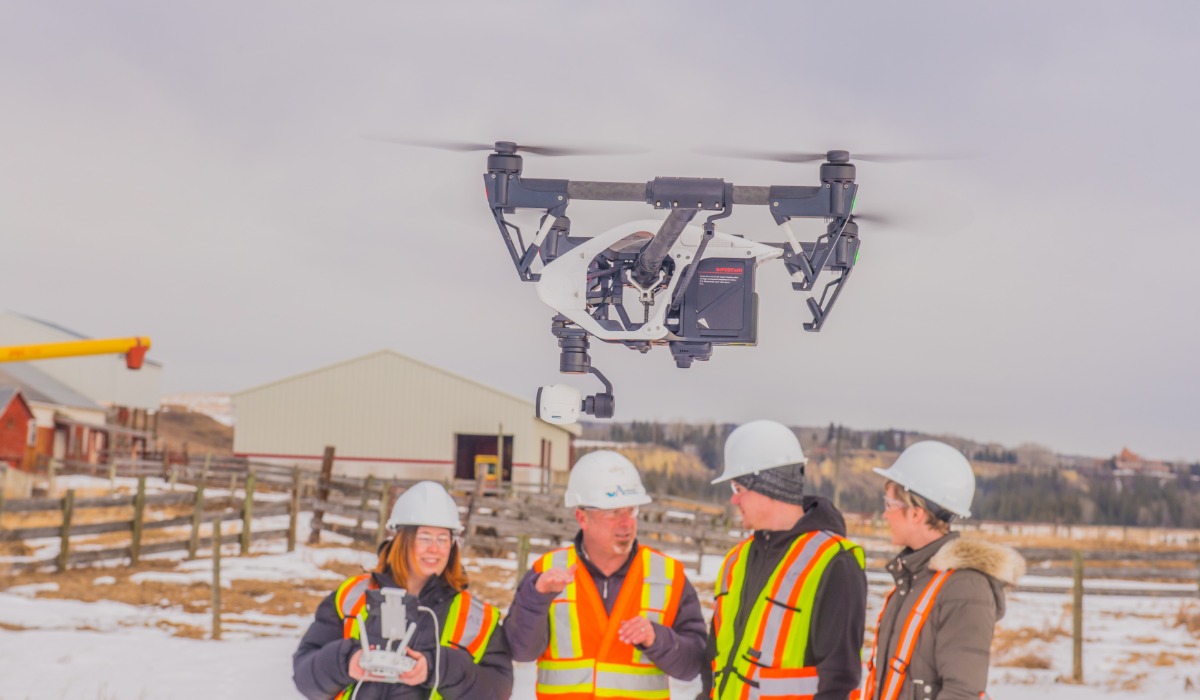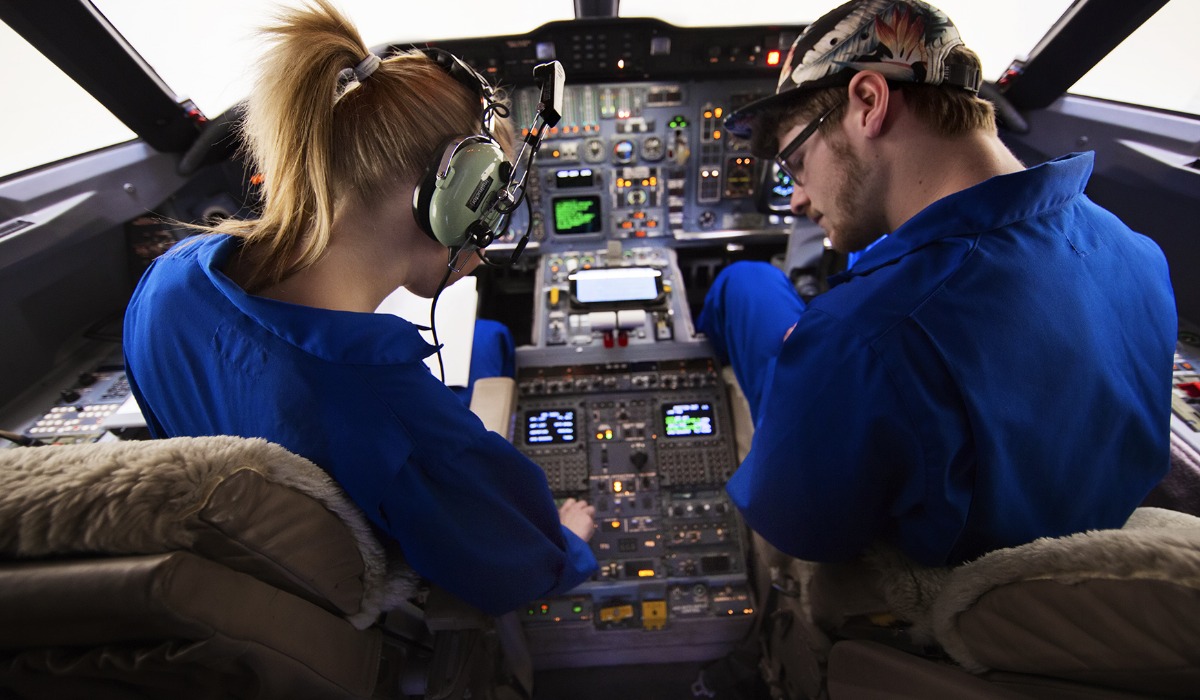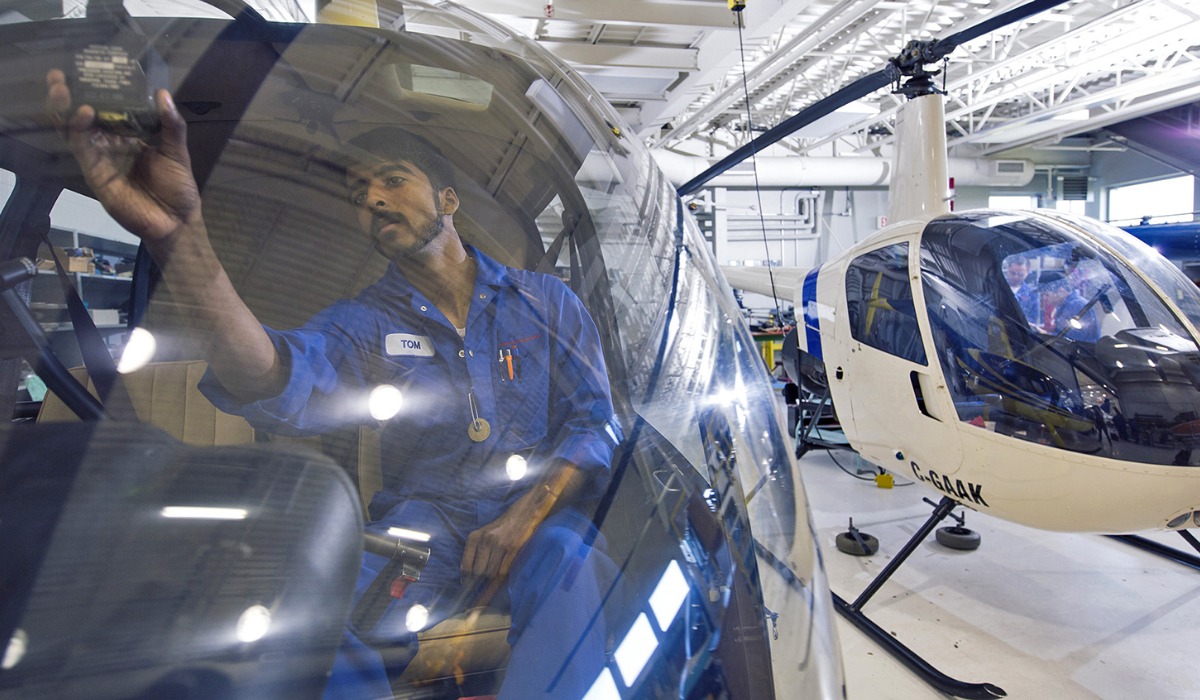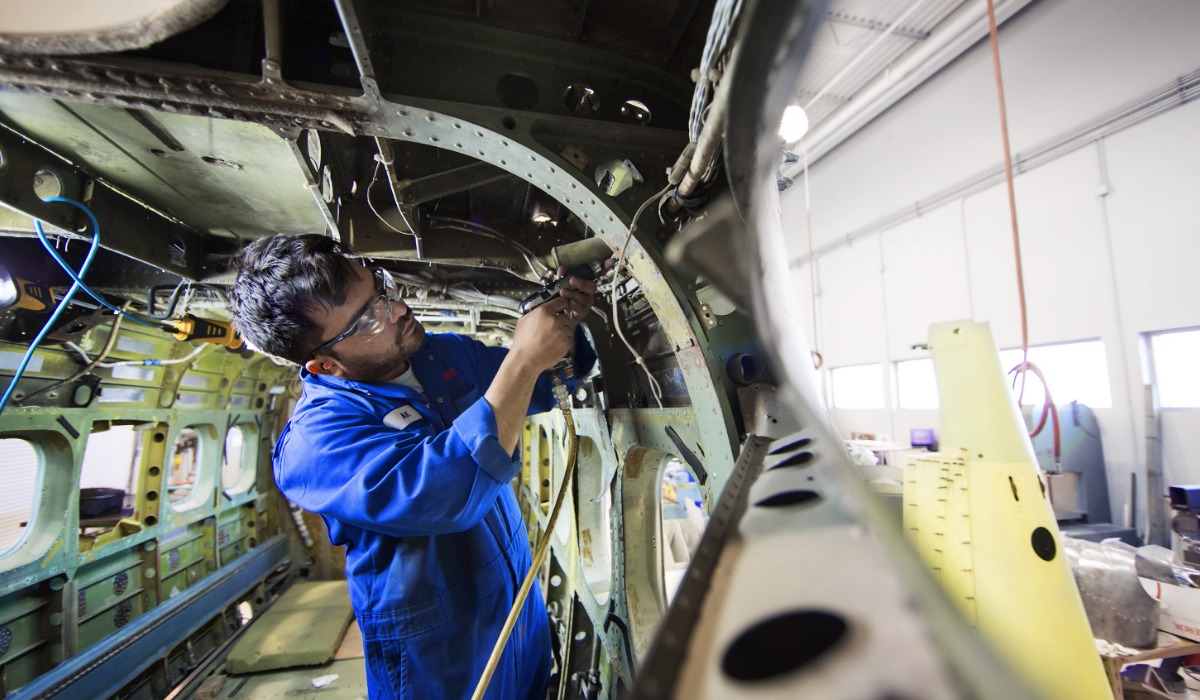Overview
Launch a cutting-edge career with our Professional Remotely Piloted Aircraft Systems (RPAS) program, designed to equip you with the knowledge and skills to operate drones across various commercial sectors.
As industries such as agriculture, forestry, oil and gas, energy, construction, cinematography and emergency response rapidly integrate drone technology, the need for qualified pilots continues to increase.
This program offers a comprehensive education that includes the construction, maintenance and operation of drones, familiarization with Transport Canada's stringent aviation guidelines, and hands-on experience with geomatics data. You'll also learn to conduct inspections and mapping for environmental, agricultural and industrial applications and become familiar with the key elements of Beyond Visual Line of Sight (BVLOS) operations and their business applications.
As a student, you will be trained to:
- create basic GIS-ready data outputs from RPAS projects
- coordinate RPAS flight operations with various RPAS pilots and projects
- lead RPAS teams in high-risk, complex operations
- carry out complex image analysis and create high-level geospatial outputs for RPAS projects
- develop policy for RPAS operation at the company or federal level
- ensure company compliance and site audits
- contribute to your company's business plan and design.
You will develop the technical skills necessary to navigate the technology of unmanned aerial vehicles (UAV) and the strategic insight to enhance company value and comply with regulatory standards.
Once you graduate, you'll be prepared to become a drone pilot and take on pivotal roles within your organization, leveraging RPAS technology to meet and exceed business objectives and client needs in many rapidly evolving fields.
Following Transport Canada's requirements, remotely piloted aircraft system (RPAS) pilots must:
- not suffer from any condition which would render them unfit to perform their duties
- have a visual acuity of 20/20 (the use of corrective lenses to achieve this is acceptable)
- have sufficient English language ability to be understood by local air traffic control when using VHF radio
- provide evidence of good health
- be a Canadian citizen or a permanent resident.
To become a drone pilot and operate RPAS, you'll also need:
- a strong interest in aviation
- the ability to think in 3D
- strong concentration skills
- the ability to remain calm under pressure
- IT and math skills
- the ability to make quick decisions in emergencies, give accurate instructions and accept considerable responsibility.
Graduates will be certified in:
- Transport Canada Advanced Small Remotely Piloted Aircraft System (RPAS)
- Visual Line-of-Site (VLOS) pilot
- Restricted Operator certificate with Aeronautical qualification (ROC-A).
After successfully completing this program, you'll receive a SAIT Professional Remotely Piloted Aircraft Systems certificate.
Careers and opportunities
Each year, SAIT conducts a survey between February and April to determine the employment rate, salary and satisfaction of our newest SAIT alumni.
![]() 75% graduate employment rate
75% graduate employment rate
Find out more about our graduate employment statistics >
Our graduates may work in the following occupations. Some careers require additional experience and education.
Associated National Occupational Classification (NOC) codes: 22230, 41201, 52110, 22213, 22101.
Career planning support
Unsure which career path is for you? Here are some recommended career planning resources to help you decide your future.
You can also head to Alberta alis for lots of information about careers in Alberta, including quizzes and labour market information to help you narrow down a path.
Finally, you can take our online career finder quiz, which can help narrow your options based on your current skills and interests.
Courses
The Professional Remotely Piloted Aircraft Systems certificate requires 18 credits (eight courses) to complete.
| Course | Credits |
|---|---|
|
In this course, you'll build on your RPAS mapping knowledge to develop advanced data understanding and interpretation skills. You'll enhance your photogrammetric skills through the derivation of orthophoto mosaics, digital terrain models (DTM), digital elevation models (DEM) and digital surface models (DSM). You'll also expand your knowledge of surface development by processing LiDAR data, and run comparisons between photogrammetry and LiDAR data to generate additional products such as tree canopy models and volumetric calculations. |
1.5 |
|
This course introduces you to the mapping process for remotely piloted aerial systems (RPAS). You'll describe the components of an RPAS, and use specialized software to generate maps to support field operations and create RPAS mission plans. You'll use global navigation satellite system (GNSS) technology to derive ground control points (GCPs), and you'll process existing imagery data as well as data you collect during field missions using photogrammetry software. |
1.5 |
|
In this course, you'll examine the specific regulations and procedures that apply when flying beyond visual line of sight (BVLOS) missions with remotely piloted aircraft. You'll conduct operational risk assessments (ORA), determine the airworthiness of an aircraft and explore the challenges specific to BVLOS environments. You'll also complete a Transport Canada application package and get hands-on experience preparing for and conducting your own BVLOS missions. |
3 |
|
In this course, taken concurrently with RPAS - Professional Operations and Planning, you will use the skills you learn to execute an RPAS mission from planning to completion. As you develop and refine the workflow of a mission, you'll get hands-on experience in RPAS operations, including multi-rotor and fixed-wing RPAS, under the guidance of experienced operators. Topics include mission planning, dispatch, on-site assessments, operational flight skills, data collection, and post-flight operations. You'll also learn how to respond to emergency situations. At the end of the course, you will complete Remotely Piloted Aircraft Systems - Flight Reviewer based on Transport Canada's requirements, which allows you to obtain the Pilot Certificate for Small Remotely Piloted Aircraft Systems (VLOS)-Advanced Operations. Corequsites:
|
3 |
|
In this course, you'll build on the skills you learned in ground school and flight school training by focusing on the mechanics and technology of the remotely piloted aircraft itself. As well as assembling a multi-rotor RPA, you'll configure, test fly and troubleshoot it to validate its flight performance. You'll also conduct maintenance and servicing tasks on larger RPAS airframes and engines to ensure they are ready for flight. This will include various internal combustion engines, and both fixed wing and helicopter airframes. |
3 |
|
This remotely piloted aircraft systems (RPAS) course gives you the professional skills to plan, conduct and complete complex RPAS operations within Canadian airspace. Current and prospective RPAS pilots will learn effective and safe operations that incorporate important mandatory knowledge requirements. You'll explore a range of topics including Canadian regulations and best practices, site assessments, meteorology and dispatch. You'll also examine pre-flight, flight operations and post-flight activities and emergency procedures. Finally, the information presented in this course will prepare you to challenge Industry Canada's Radiotelephone Restricted Operator Certificate-Aeronautical (ROC-A) and TC RPAS Small Advanced exam required by CAR Part IX. |
3 |
|
In this course learners are introduced to Visual Testing (VT) methods which allows technicians to locate defects in many materials. Learners work with various equipment and accessories and follow inspection procedures and standards outlined by industry and regulatory groups. |
1.5 |
|
In this course, you'll use the skills you've developed during the program to propose and develop a project pertaining to an aspect of RPAS operations that interests you. You'll then complete the proposed mission, collect data, analyze the results and report your findings and recommendations to stakeholders. |
1.5 |
Progression
You must attain a PGPA and/or a CGPA of 2.0 or better each semester and pass the prerequisite courses to progress through the program.
To qualify for graduation, you must pass all courses, attain a CGPA of 2.0 or better and complete course requirements within the prescribed timelines.
Admission requirements
Applicants educated in Canada
Applicants must demonstrate English language proficiency and completion of the following courses or equivalents:
- a minimum of 50% in English Language Arts 30-1 or English Language Arts 30-2, and
- a minimum of 50% in Math 30-1 or Math 30-2, and
- a minimum of 50% in one Grade 12 Science course.
SAIT accepts high school course equivalents for admission for applicants educated outside of Alberta.
All applicants who were educated outside of Canada must demonstrate English language proficiency and provide proof they meet the program admission requirements outlined above with an international document assessment. Find accepted educational documents and assessment options.
SAIT may also accept courses completed at certain international post-secondary institutions.
Academic Upgrading
Missing an admission requirement for this program? Upgrade your prior education to help you receive admission into one of SAIT's career programs.
English language proficiency
All applicants must demonstrate English language proficiency prior to admission, including students educated in Canada.
Transfer agreements
At SAIT, we have created transfer agreements with partner institutions to allow you to earn course credits toward your SAIT program based on your previously completed credentials.
Transfer Alberta search tool
Use the Transfer Alberta search tool to see all transfer agreements between Alberta post-secondary institutions (including those with the University of Calgary, Mount Royal University and Bow Valley College.)
Search transfer agreements in Alberta
Transfer options for graduates
When you have completed this program, you may continue your education at a partner post-secondary institution. These transfer agreements include partnerships within and/or outside of Canada.
Available intakes
Spring 2026
Start dates:
- Domestic students: Open
-
-
Application deadline: April 30, 2026
-
- International students: Open
-
-
Application deadline: March 27, 2026
-
Costs
2025/26 tuition and fees
The following estimated costs are effective as of July 1, 2025.
The estimated total cost of tuition and fees is based on completing the program in one semester of study. Following a modified schedule will impact the fees you pay per semester and may alter final costs.
Domestic students
The program total is based on the estimated amount you will pay if you enter this program during the 2025/26 academic year. The program total amount listed on your letter of admission may appear higher. This amount is your maximum tuition guarantee for the program. SAIT will not exceed this maximum, regardless of changes in tuition and fees between academic years.
Books are approximately $50 - $150.
This is a bring-your-own-device program with a standard computer hardware and software requirement. See the specific requirements on our computers and laptops page.
Find your booklist on the SAIT Bookstore's website. The booklist will be available closer to the program start date. Can't find your program or course? The bookstore didn't receive a textbook list. Contact your program directly to determine if they're still refining course details or if you're in luck; no textbook purchase is required this term.
Required equipment/tools
You'll require a drone build kit, which can be purchased from SAIT for approximately $1,000 - $1,200. This kit will be used to build and understand how all the components of a basic drone work.
A tool list and timeline for purchasing the required items will be provided at orientation.
Required personal protective equipment (PPE)
You'll be required to use personal protective equipment (PPE) when working in the shop and performing flight duties. Some of this equipment can be purchased from SAIT and others will need to be sourced elsewhere. The cost for PPE is between $250 to $400.
A PPE list and timeline for purchasing the required items will be provided at orientation.
Financial aid
Paying for your education may feel overwhelming, but we have resources and programs that can help, including information about payment options, student loans, grants and scholarships.
Application process
Ready to apply?
Follow our step-by-step guide to submitting a successful application.
Communication during admission
Email is the primary source of communication during the selection process. Ensure your personal email account is managed appropriately to receive our emails, files and communications. We recommend you add the transportation.info@sait.ca domain to your safe senders list or you risk missing critical email messages.
Begin your application
Apply now using the online application portal.
Ensure you have a valid Visa or Mastercard to pay the non-refundable application fee of $120 for domestic applicants.
Information sessions
Prepare for a strong start in your chosen program or get the details you need to decide your future path.
Our expert staff and faculty are ready to answer your questions and provide information about the following:
- What sets SAIT apart
- An introduction to the program and area of study
- Admission requirements
- Future career paths
- Information on the earning potential and graduate employment rates.
Contact us
School of Transportation Advising
-
Phone - 403.284.8471
Subscribe for updates
Your journey starts here! Sign up to get important updates on:
- Transportation and logistics programs
- Application information
- Relevant news and events

Oki, Âba wathtech, Danit'ada, Tawnshi, Hello.
SAIT is located on the traditional territories of the Niitsitapi (Blackfoot) and the people of Treaty 7 which includes the Siksika, the Piikani, the Kainai, the Tsuut’ina and the Îyârhe Nakoda of Bearspaw, Chiniki and Goodstoney.
We are situated in an area the Blackfoot tribes traditionally called Moh’kinsstis, where the Bow River meets the Elbow River. We now call it the city of Calgary, which is also home to the Métis Nation of Alberta.




